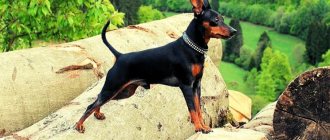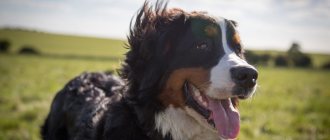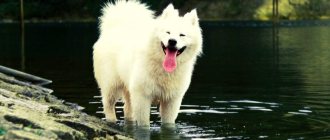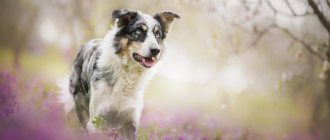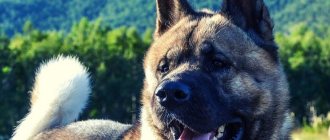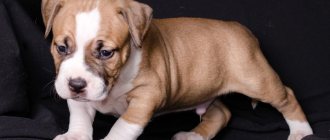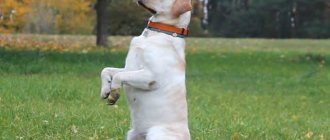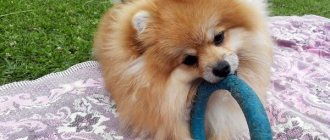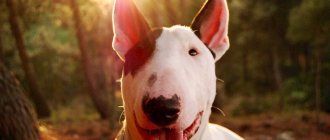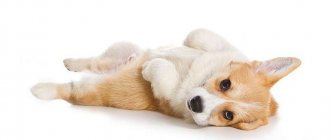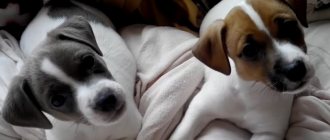| Aggressiveness |
| Upbringing |
| Training |
| Intelligence |
| Shedding |
| Behavior with children |
| Watchman |
| Security guard |
| Difficult to care for |
| Endurance in the cold |
| Endurance in the heat |
| America (Alaska) | |
| Lifespan | 10 - 12 years |
| Height male | 61–66 cm |
| Rising bitch | 56–61 cm |
| Weight male | 36–43 kg |
| Weight bitch | 32–38 kg |
The Alaskan Malamute cannot be called anything other than a heavy-duty dog. Designed for harness work, it was the only means of transporting goods in the snowy and cold north. The Malamute, whose photo depicts a dog in its usual conditions, looks harmonious in snowy areas and frosty air. His entire appearance echoes the local flavor, emphasizing the dog’s endurance. The eyes of a malamute can carry you away to the endless expanses of the north; they reflect loneliness and tranquility.
Interesting! Malamutes can withstand up to -70 degrees and love to sleep in snowdrifts, even if kept in a country house in an enclosure with a kennel.
Despite its large build, the Alaskan Malamute is unusually active and agile. In urban conditions, the breed lost its original functional characteristics, and Malamutes became companion dogs living in apartments and houses. They love to be the center of attention, especially when they are puppies. Thanks to their “hairiness”, which makes them look like fluffy bear cubs, they easily manage to be everyone’s favorites.
More recently, in 2010, the Malamute became a symbol of Alaska. This state is the birthplace of the breed, and the dog is the personification of this harsh region, as it combines the endurance and strength necessary to exist in the northern climate.
Malamute is a representative of the “Northern Sled Dogs” section, belonging to group 5 according to the FCI qualification (Spitz and primitive dog breeds).
Origin of the Malamute
The Alaskan Malmouth is recognized as one of the oldest dogs of the aboriginal type. Its formation was strongly influenced by the landscape and climatic conditions of the north and the economic activities of the inhabitants living in Alaska. It was subjected to folk selection by the Inuit tribe Melemyut, from which it received its name. The Inuit are Aboriginal people who inhabited Canada, Greenland and Alaska.
Interesting! Malamutes very rarely bark, which is explained by its origins from the wolf. Dogs of this breed grumble, which is not typical for other breeds.
It is believed that Malamutes are direct descendants of wolves. This is evidenced by the similarity in appearance and the presence of a large number of common genes. If you compare the appearance of a wolf and a malamute, the differences are insignificant. But the pet's appearance has changed and adapted to its purpose. A wider chest, stockiness, a raised tail, a shorter and wider muzzle - everything that distinguishes dogs of the breed from a wolf.
The Malamute dog was found several hundred years ago. Travelers and explorers noted that local residents use the hardy and large animals to transport goods. There is every reason to believe that these were precisely the ancestors of the modern Alaskan Malamute.
Archaeological finds indicate an even earlier existence of these dogs. At the end of the 19th century, during the “gold rush”, a completely new stage in the history of the breed began. They were used as the only trouble-free transport, the so-called Snow Train.
The breed was formed in isolation from the rest of the world, and was used as a sled dog for 4-6 centuries. It is noteworthy that it never lost its identity, even after being crossed with breeds imported from other states during the Gold Rush.
History of appearance
The history of the origin of Malamutes is replete with many facts. These dogs were popular among both the Malemute tribe and the Eskimos. The main task of the dogs was to drag heavy loads and ride in a sled. The dog was used to help hunt seals and polar bears.
"Feverish" stage
The “Gold Rush” that hit Alaska contributed to the growth of the dog population. The fact is that gold miners assessed the external characteristics and working abilities of the breed.
There were a lot of people who wanted to mine gold and get rich. But not everyone was able to adapt to the harsh conditions of Alaska. Many were not even able to reach their destination. These events are described very well and colorfully in the book by Jack London.
There is also a negative side to the fact that the dog was so popular among gold miners. Gold miners began randomly crossing Malamutes with other dog breeds, wanting to increase their speed and endurance. It was quite expected that the number of purebred representatives of the breed has greatly decreased.
Present tense
But, as you know, everything in the world passes, and the gold rush passed.
The Americans switched to sports and became interested in luge competitions. There was a need to return the breed to purity, because only a true representative with pure blood could win the races with dignity. Targeted work has begun to increase the number of Malamutes. The breed achieved official recognition throughout the world in 1935. At the same time, the first standard was developed.
During the Second World War, there was an urgent need for sled dogs. A large number of Malamutes were sent to the front, from where they never returned. Callous people often left dogs to die of hunger.
There are known cases of simply terrible attitude of forwarders who have been to the Arctic towards Malamutes. Arctic dogs were simply blown up after they had completed their mission and provided the necessary assistance to people.
The next desire of mankind to restore the breed reached its peak at the end of the war. In 1947, work began again, requiring a large amount of material costs and human effort. The population began to grow, and in the early 70s it was already known outside the country.
The Alaskan Malamute breed was recognized as the symbol of the United States in 2010.
Characteristics of the Alaskan Malamute
Characteristics of the Malamute:
- active, friendly dog with high intelligence. She gets along well with people, since even during the formation period, the Alaska Indians reinforced such a trait as good nature in the breed. It was necessary, because the dog lived in close proximity to the person and transported him;
- does not like to obey and is independent. In order to form obedience in her, it is necessary to pay attention to her upbringing in the first days.
- The Malamute, whose characteristics would seem to indicate the opposite, is extremely non-aggressive and gets along well with children. He won’t even scare strangers by barking, he practically doesn’t bark;
- The breed is characterized by a pack instinct, which goes back to ancient times, because the dog worked in a harness. The Malamute will feel great in a family;
- Malamute does not like loneliness;
- This breed is not a hunter and is completely unsuitable for guard purposes. They can even be friendly towards a burglar.
The Malamute's endurance and strong physique are characteristics that made it possible to transport loads several times its weight over long distances. Wide and powerful paws help to move along the surface of the snow without falling through.
The endurance of dogs has been used in various fields. The owners of Malamutes are not always able to provide them with harsh northern conditions, but the breed willingly participates in riding for children and cyclists, sledding sports, and tugging competitions. Even while hiking, a dog can carry a backpack and enjoy it.
Dense and thick wool protects against cold weather; in the warm season, the hair becomes thinner and shorter. Among Malamutes, dogs with gray and wolf colors are more common; black and white, gray and white, red and white, sable, sand, and red colors are also typical. The only acceptable solid color is white.
Within the breed, there is variation in height and weight, but the ideal indicators are height for males - 63.5 cm, for females - 58.5 cm. By weight: 38 and 35 kg, respectively. Alaskan Malamutes live from 12 to 15 years.
Possible defects
The main task of Alaskan Malamutes is to transport heavy loads, which requires ideal paw condition.
Any deviations in the shape of the limbs that affect the manner of movement or stance are usually regarded as a developmental pathology. The most common defects are:
- Straight shoulders.
- Weak pasterns.
- Widely spaced hindquarters.
- Insufficiently developed muscles.
- Excessive weight.
- Weak bones.
- Body disproportion.
A movement pattern that differs from that prescribed in the standard is considered insufficiently effective and is therefore also considered a breed defect.
The definition of an identified deviation from the standard as a defect depends on how pronounced it is and how capable it is of affecting the health of the individual as it grows. Disqualifying faults
The basis for culling an individual is considered to be the presence of physical characteristics that do not meet the standard. A male dog can also be disqualified if it is discovered that he has underdeveloped testes or undescended testicles into the scrotum. Dogs that show excessive aggression towards other animals, humans, or experience paralyzing fear when placed in an unfamiliar situation are subject to culling.
Diseases of Alaskan Malamutes
Diseases of Alaskan Malamutes are genetic or acquired. Among the common inherited ailments is the so-called “snow nose” - a lack of pigmentation on the pet’s nose. A pale pink nose should alert you to a veterinarian.
Chondrodysplasia - impaired development of cartilage tissue - is a dangerous genetic disease. The first symptoms: the dog gets tired quickly, the previously active dog does not want to play or even get up, and lies with its paws spread out in front. Weakening of the joints can lead to a unfortunate situation where the Malamute will not be able to run at all.
Proper care and balanced nutrition are the key to a dog’s health. But not a single Malamute is immune from diseases associated with the musculoskeletal system. The large weight of the animal cannot but affect the joints. Obesity will only worsen the problem, so experts advise not to overfeed your pet. If when stroking you can easily feel the ribs and spine, then you are on the right track and the dog is not in danger of becoming obese.
Malamutes have a wide chest, and all dogs with this anatomical feature are susceptible to volvulus. If you notice bloating in your animal’s abdomen and it doesn’t feel well, then this is a reason to contact a veterinarian.
Eye problems are also common among Alaskan Malamutes:
- day blindness, or hemeralopia;
- progressive retinal atrophy, which can lead to blindness.
The absence of hereditary diseases and proper care guarantee your dog's longevity. The Malamute will delight you with its excellent health, energy and friendliness.
For a private home
A country house is an ideal place for a Malamute to live. To make your pet feel comfortable, you need to equip him with a spacious enclosure and a large booth with wooden flooring. Malamutes are northern dogs with thick hair and a dense undercoat, so they feel more comfortable in cool weather.
You need to be prepared for the fact that your pet will completely tear up the entire yard. This is not a simple whim and self-indulgence, but an instinctive need for survival. Lemmings form the basis of the diet of the Malamute's ancestors, and breeders were unable to eradicate this feature during breeding.
Malamute care
The Malamute is a dog accustomed to being in open spaces and being transported over long distances, so those who are thinking of getting this breed are concerned with the question: are they suitable for keeping in the house, how well will the Malamute feel in an apartment ? If your pet's daily routine includes multiple walks lasting at least an hour, then the malamute will not suffer.
Representatives of the breed are very clean, which is what captivates residents of city apartments.
Combing and washing
Long hair requires constant care. She needs to be brushed about 3-4 times a week, especially during the shedding period. Otherwise, there is a risk of finding scraps of fur everywhere. Malamutes love to swim and don’t miss a single body of water. They will also be delighted with a bath filled with water. General recommendations for bathing them:
- the use of special products that are non-toxic and do not cause allergies;
- drying under a hairdryer, so the thick undercoat takes a very long time to dry without a hairdryer;
- thorough combing.
Teeth should be brushed 2 times a week, and ears should be cleaned regularly with a cotton swab.
Malamute content
A place for a dog to sleep should be organized in a secluded place, protected from large crowds of people. If the owners go to work, it is necessary to leave toys, as the dog does not like loneliness.
The Malamute, whose care requires certain habits from the owner, loves to take long walks and experience certain stress. Go for walks or bike rides, this is very useful and will help you avoid obesity and release pent-up energy.
Malamutes, even in the city, remain northern animals, so they are susceptible to heat. Walking in extremely hot temperatures is not the best option. The number of walks should not be less than 2 times a day. If a malamute digs a hole during a walk, this is not a deviation, but one of the characteristics of the breed, since in natural conditions dogs obtained food by tearing rodents out of the ground.
Nutrition
The Malamute is large in size, but requires much less food to feed it than other breeds of the same size. But they have a drawback related to food: they love to steal food and are not averse to grabbing anything that is left unattended.
Dogs can be fed prepared food or natural food, do this 2 times a day. Switching to single meals is fraught with volvulus. Veterinarians advise switching to two meals a day after 4 months, and before this age, meals 3 times a day are encouraged. The Malamute should have free access to fresh water.
How to train?
Representatives of this breed can be trained from early childhood, gradually accustoming the dog to basic commands. More serious training requires pets to be approximately six months old. During this period, it is easier for them to perceive complex commands from the owner or dog handler.
At home
The main thing is not to overdo it at the initial stage and not to bring the puppy to the point of completely refusing to accept the desired position. Due to its activity, it can be difficult for a Malamute to stand still, so you will have to be patient, treats and gentle words. At the same time, he will accept commands for active action with joy.
With a dog handler
Malamutes are pack animals. The most important thing is to show your pet at first who plays the role of leader in the “pack”: an experienced dog handler knows the shortest path to such mutual understanding. These dogs are very smart, love to make independent decisions, soberly assess the situation and change their behavior if they deem it necessary. This is not to say that training a small Malamute is a difficult task, rather troublesome, but interesting.
Raising and training a Malamute
Raising a Malamute must take into account two features of the breed's psychology: the desire for dominance and the pack instinct. Based on them, the education system is thought out. For a Malamute, the family into which he was adopted is a pack, and the owner’s task is to show by example, day after day, that he is the most non-dominant member of the pack. This should happen in an atmosphere of respect, understanding, care and praise, only in this case you will get the right dog with whom you want to live.
Malamutes are not easy to train; they even have difficulty getting accustomed to traditional commands. The main principle in education should be praise, because it is very important for a dog of this breed to receive the approval of the “pack leader,” that is, the owner. Rudeness in dealing with a dog will lead to its cowardice, and constantly being alone can lead to pogroms in the apartment: the Malamute needs something to play with, and everything that comes across the room can become toys.
When communicating with a dog, your gaze and tone of voice are important. If the dog has done something that you do not approve of, look at it closely until it looks away, this is tantamount to its defeat. Confidence and calmness, and no baby talk - this is exactly what the owner’s voice should radiate.
Training and habit formation should begin while the Malamute is still a puppy. The dog must follow the rules of behavior: do not allow it to do things that you do not approve of, for example, sleeping on the owner’s bed. If you allow something once, it will be difficult to wean off unwanted behavior in the future.
What to feed for the first 3 months?
During the first 2-3 weeks, the puppy's food consists only of mother's milk. If for some reason this is not possible, you should purchase a substitute (for example, Royal Canin Babydog Milk) or use baby food without lactose and sugar.
When the puppy is approximately 20 days old, complementary foods in the form of calcined cottage cheese and goat's milk should be introduced into its diet..
Once the puppy reaches 1 month, the amount of complementary foods must be increased. Malamute can be given dry food pre-soaked in water, whole milk, calcined cottage cheese, boiled yolk, boiled minced beef, and low-fat broth.
At 2 months, when the puppies already have milk teeth, you can give scraped frozen meat, vegetables, fruits, herbs, dairy products, cereals, eggs.
After 2 months, whole milk should be excluded from the diet.
At 3 months old, Malamutes can eat all foods included in the list of foods allowed for this breed. All new foods should still be introduced into the diet gradually, observing the pet's reaction.
Malamute puppies
As soon as a puppy arrives in a new home, veterinarians advise quarantining it: excluding contact with other dogs, providing it with a warm room and carefully caring for it. Weaning from the familiar environment, the company of the mother and other puppies is stressful for the pet. Only the owner can make sure that the puppy is not left completely alone. Malamute puppies are very receptive to attention, care and affection. In the future, the owner will be rewarded for providing support at one time; he will become the one and only for the dog.
Active growth of the Malamute begins at 3 months; growth stops completely by 1 year. During the period from 4 to 12 months, the animal should not be loaded; movements and exercises that negatively affect the joints are contraindicated: jumping, running up steps; only smooth, rhythmic movements are allowed, for example, trotting.
The puppy is happy when he is in the center of events, so all family members should give him their time and attention. It is imperative to start training at 2 months. Simple commands (lie down, sit, come to me and others) will help you move on to more complex manipulations. Compliance with commands should be mandatory, reinforcement with praise and rewards is encouraged. You need to communicate with the puppy on equal terms; a Malamute cannot be subdued; you can only make him your companion.
Vaccination schedule
| Age | Vaccine |
| 6 weeks | Nobivac Puppy DP |
| 8-9 weeks | Nobivac DHP + Lepto (R) DHPPi |
| 12 weeks | Nobivac DHP + Lepto (R) DHPPi |
| 14-16 weeks | Nobivac Lepto |
| 1 year and beyond | Nobivac DHPPi + Lepto |
| D – canine distemper, H – hepatitis, P – parvovirus infection, Pi – parainfluenza, Lepto – leptospirosis, R – rabies |
Only a healthy dog can be vaccinated, and deworming must be carried out 2 weeks before vaccination..
Prices for Alaskan Malamutes
Let’s say right away that Malamute is an expensive breed. We advise you to purchase puppies from nurseries or professional breeders; they will be able to provide a pedigree and documents confirming compliance with the breed.
If the future object of your purchase is a malamute , the price of which depends on belonging to a certain class, then be prepared to spend from 15 to 40 thousand rubles. If you decide to buy a promising puppy who may become an international champion, then you will pay about 300 thousand rubles for it.
Pet class Malamute puppies are not intended for breeding and will only become pets. They cost from 15 to 20 thousand rubles. Brad class puppies meet the standards and are suitable for breeding; their price ranges from 20 to 35 thousand rubles. Representatives of the show class - participants and winners of exhibitions - cost from 35 to 45 thousand rubles.
Feeding
Special attention should be paid to the issue of feeding your pet. You need to immediately decide on the type of feeding so as not to injure the animal or harm its health. Many people believe that any food that is advertised hourly on TV is better than natural food.
It is not always so. On TV, low-quality feeds that do not contain the necessary components are often praised. You should not feed your pet economy class food. If you are going to make a choice in favor of dry food, then you need to choose those that have a class no lower than premium.
The advantage of natural food is that the owner himself can control its quality. But here you also need to take into account that feeding must be correct and well-balanced.
Veterinarians recommend not mixing dry food with natural food.
Photos of malamutes
Below are bright, colorful and realistic photos of a Malamute . This breed has its own distinctive features, which can be seen in the photographs. They will not leave anyone indifferent. The Malamute's intelligent eyes, strong build and power attract attention at first sight and you want to study every feature in the dog's appearance.
Even in the concrete jungle and apartment conditions, Malamutes exude energy, friendliness, and demonstrate endurance and strength. We offer the largest selection of photos where the Malamute is shown on a walk, playing, in the lap of nature, in urban environments.
Appearance of dogs
Now the Alaskan Malamute is divided into two species - M-Lut and Kotzebue. The first has a powerful skeleton and impressive size. The color of the coat is varied - gray with black, silver-blue with white. Kotzebue has a wolf coloration, but is smaller in size.
According to the standard, the breed must meet the following parameters:
- Strong build, strong bones, deep chest, compact body.
- The coat is hard on the outside, with a soft undercoat on the inside. It is covered with moisture-proof fat.
- The height of males is 60-63 cm, females - from 57 to 59 cm.
- Normal weight is 35-38 kg.
- The head is wide, harmonious in proportion with the body.
- The muzzle is voluminous, not elongated or pointed.
- The ears are triangular, the tips are rounded. They are standing and have a wide stance.
- The jaws are large, the teeth are large and sharp.
- Lips are close.
- Scissor bite.
- The eyes are small, almond-shaped, slightly slanted. The iris is brown. If it is blue, then this is a pathology.
- The nose is black, sometimes brown in red animals.
- Broad chest, straight back, muscular lower back.
- The tail is curled and carried higher than the back even in a neutral mood.
- The paws are powerful and resemble the limbs of a bear.
At what age do you start training?
Puppy training must begin from the very first days
the presence of a dog in your home. Because already from infancy, the puppy must learn the rules of behavior in your house, what is allowed and what is forbidden, how to behave with all family members, even the smallest and oldest, what he can play with and what he can’t, where to go. toilet and much more.
And we are talking, first of all, about the proper upbringing of an Alaskan Malamute puppy, and you can start training and learning commands when the puppy is completely comfortable in your home. As a rule, one week is enough. By this time, the puppy is already filled with curiosity and is diligently exploring the world around him. If, after this time, the puppy remains fearful and does not make contact well, then it is better to seek help from a dog handler-animal psychologist, because This behavior is not typical for puppies of this breed.
When can you start training with a dog handler?
The beginning of the puppy's training coincides with the time of the first exit to the street. When the first two vaccinations have already been done, the quarantine (lasts 7-14 days, depending on the vaccination) after them is over. It is not at all necessary to train your puppy only outside; the first sessions are best done at home, where there are fewer distractions.
Often new puppy owners worry that training from the first days will be excessively stressful for the dog. This is only possible if outdated, rigid methods are used, and with the right approach, training from the first days will, on the contrary, be very useful, since it allows you to immediately establish contact
with the puppy and build a trusting relationship.
You can start raising a puppy from the first days of its appearance in your home, and training and classes with a dog handler can begin simultaneously with the start of walks, when quarantine ends after the second vaccination.
Why you don't need to wait up to 6 months
When is weaning from the mother?
In the first 20 days of life, the puppy is completely dependent on the mother, at least because her milk is his only food.
After the introduction of complementary foods, the puppies' relationship with their mother becomes less close, they begin to feed, walk and play independently. The task of the bitch comes down only to teaching the offspring basic norms of behavior.
The most suitable age to buy a puppy is 8-12 weeks . At this time, the baby is already completely independent and absolutely independent of the mother, but is not yet accustomed to the owners and has not yet developed and consolidated any behavioral habits.
